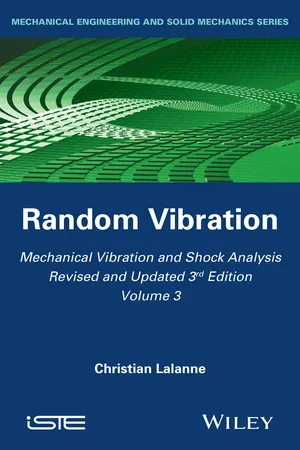
- English
- ePUB (mobile friendly)
- Available on iOS & Android
Mechanical Vibration and Shock Analysis, Random Vibration
About This Book
The vast majority of vibrations encountered in the real environment are random in nature. Such vibrations are intrinsically complicated and this volume describes the process that enables us to simplify the required analysis, along with the analysis of the signal in the frequency domain.
The power spectrum density is also defined, together with the requisite precautions to be taken in its calculations as well as the processes (windowing, overlapping) necessary to obtain improved results.
An additional complementary method – the analysis of statistical properties of the time signal – is also described. This enables the distribution law of the maxima of a random Gaussian signal to be determined and simplifies the calculation of fatigue damage by avoiding direct peak counting.
Frequently asked questions
Information
Chapter 1
Statistical Properties of a Random Process
1.1. Definitions
1.1.1. Random variable
1.1.2. Random process
Complexity of the analysis


1.2. Random vibration in real environments
1.3. Random vibration in laboratory tests
Table of contents
- Cover
- Table of Contents
- Title Page
- Copyright
- Foreword to Series
- Introduction
- List of Symbols
- Chapter 1: Statistical Properties of a Random Process
- Chapter 2: Random Vibration Properties in the Frequency Domain
- Chapter 3: Rms Value of Random Vibration
- Chapter 4: Practical Calculation of the Power Spectral Density
- Chapter 5: Statistical Properties of Random Vibration in the Time Domain
- Chapter 6: Probability Distribution of Maxima of Random Vibration
- Chapter 7: Statistics of Extreme Values
- Chapter 8: Response of a One-Degree-of-Freedom Linear System to Random Vibration
- Chapter 9: Characteristics of the Response of a One-Degree-of-Freedom Linear System to Random Vibration
- Chapter 10: First Passage at a Given Level of Response of a One-Degree-of-Freedom Linear System to a Random Vibration
- Appendix
- Bibliography
- Index
- Summary of Other Volumes in the Series